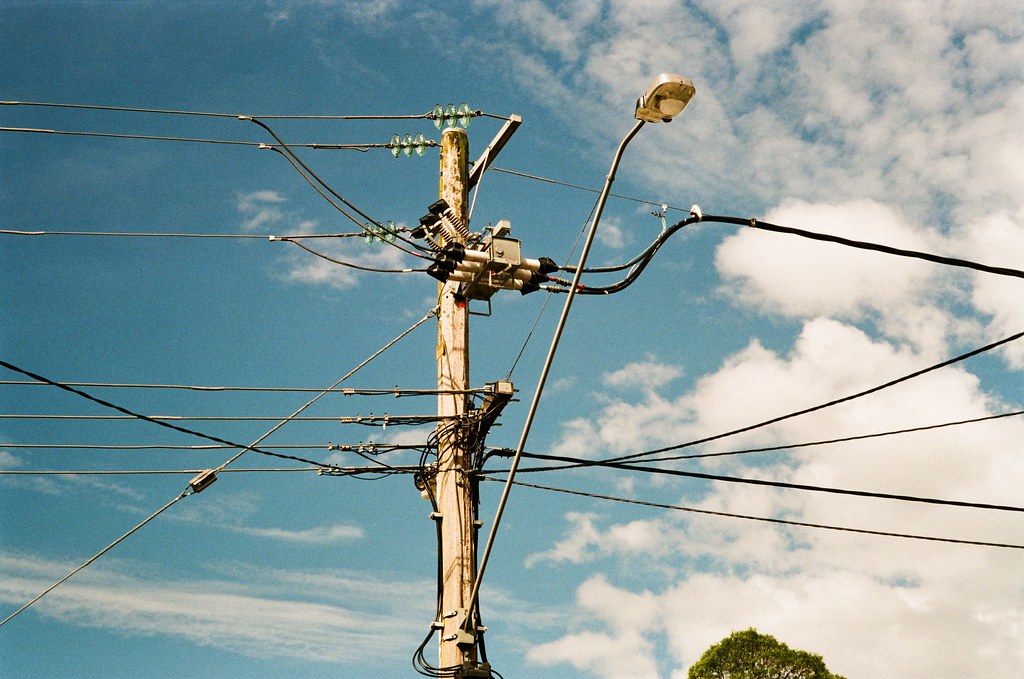Do you have power lines near or on your property but are not sure how close you're allowed to build to them? It's an important thing to know for both safety and legal reasons. Electricity is something that's so a part of our everyday lives that we sometimes forget how dangerous it can be. Before performing any building around power lines, it's essential to know the regulations regarding how close you can build and the safety precautions you should take.
In this article, we'll look at the restrictions and details around building near powerlines and provide some general tips.

Considering installing your own power pole? Click here to read our complete guide!
What planning rules apply to building a home near power lines?
The first thing to understand is that not all power lines are the same. The number of kilovolts (kV) a power line transmits will play a major role in determining.
The two main types of power lines are transmission lines and distribution lines. Transmission lines are much more likely to be an issue in rural areas than in the city or suburbs. Distribution lines are the network that delivers electricity to businesses and homes. These poles are the ones you're much more likely to see near your home.

While it can vary depending on the situation, you're usually not allowed to build any obstruction or structure within five metres of a powerline without prior permission.
There are exceptions such as fencing, gardening and minor structures such as barbeque or playground equipment, provided they don't completely block access to the easement.
Though it is possible to get an exemption to build under powerlines, the odds are this won't happen if there are any other viable options.
PowerLine Exclusion Zones
When reading about building around powerlines, you'll come across the term exclusion zones. An exclusion zone is a minimum safe distance you need to be during a build to remain safe and avoid electric shock or damaging the powerlines.
For the most part, exclusion zones are:
- 3 metres for voltages up to 132kV
- 6 metres for voltages up to 330kV
There are instances where a worker can be within these exclusion zones, however, an authorised person from the power provider or council needs to approve this. You can commence any work that is outside that exclusion zone before receiving safety approval. You cannot however start anything within the exclusion zone. For further information, it's best to speak with whoever owns the easement on your property.

Tips & advice to help ensure you remain compliant
Transmission lines vs distribution lines
There are two main types of power lines and, yes, they will play a role in determining where you can build. Transmission lines allow large quantities of electricity to travel over a long distance and are more common in rural areas. If you're building in the city or suburbs, you're much more likely to be dealing with a distribution line, which has a lower voltage.
Due to transmission lines having more kV, the exclusion zones have a wider clearance. This doesn't mean that distribution lines aren't dangerous, just that you can build closer to them.

Insulated power lines vs bare
The minimal distance will depend on the kV travelling through your powerlines, the types of conductors will also play a part in where you can build. Though it'll need to be confirmed by an expert, you can usually expect to add another 1m to any clearance when dealing with a line that is bare compared to an insulated line.

Proposed building dimensions
The dimension of a proposed building near a powerline will depend on the type of structure, or even which part of the structure is under consideration.
Open areas, such as balconies, decks and walkways require a larger clearance level than areas that don't - such as enclosed rooms. Areas like your roof, carport or pergola can usually be closer to powerlines. Any parts of the structure that don't provide access to people can be even closer.
Easement Regulations
Power poles, underground powerlines, stays and substations are all considered easements and are the property of the power provider
Ensuring safety during the build phase
During the building stage, contractors need to maintain their distance when it comes to using machinery, equipment and even when carrying materials.
You don't need to touch a powerline to risk an electric shock, so it's better to be over-cautious when working around powerlines.

Other regulations
Swimming Pools
Swimming pools can NEVER be built under powerlines, regardless of clearance levels. The reason for this becomes pretty obvious when you consider what a disaster it would be for a fallen powerline to land in a pool.

Areils/Television Antennas
Your ariel can't be higher than a power line and shouldn't be within the exclusion zone.
Irrigation pipes or systems
Whether you've got a water system for agricultural land or just for the lawn, you need to make sure that the projection of the water can't hit the powerlines. Water and electricity are a dangerous mix, and it's a mistake you can't afford to make once.

Talk to an experienced builder broker to ensure you remain compliant
When it comes to being compliant, there can be a lot of ins and outs. Unfortunately, it can be easy to miss something and that can result in a fine. Buildi can help guide you through the entire building process, and ensure your build is both compliant, and that you remember to take care of every step. We've saved clients both time and money during their build, so why not get in touch to see how we can help you?

